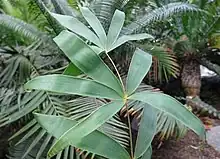| Ceratozamia hildae | |
|---|---|
 | |
| Scientific classification | |
| Kingdom: | Plantae |
| Clade: | Tracheophytes |
| Clade: | Gymnospermae |
| Division: | Cycadophyta |
| Class: | Cycadopsida |
| Order: | Cycadales |
| Family: | Zamiaceae |
| Genus: | Ceratozamia |
| Species: | C. hildae |
| Binomial name | |
| Ceratozamia hildae G.P.Landry & M.C.Wilson[3] | |
Ceratozamia hildae, commonly known as the bamboo cycad, is a species of cycad in the family Zamiaceae that is endemic to Mexico. It is native to the Huasteca Potosina of Querétaro and San Luis Potosí, near the Santa Maria River. C. hildae inhabits deciduous oak woodlands at elevations of 850–1,300 m (2,790–4,270 ft). It is threatened by habitat loss and over-collecting.[1]
It is the only cycad with more than two sets of leaflets per leaf internode.
References
- 1 2 Vovides, A.; Chemnick, J. (2010). "Ceratozamia hildae". IUCN Red List of Threatened Species. 2010: e.T42124A10658203. doi:10.2305/IUCN.UK.2010-3.RLTS.T42124A10658203.en. Retrieved 17 November 2021.
- ↑ "Appendices | CITES". cites.org. Retrieved 2022-01-14.
- ↑ "Ceratozamia hildae". Germplasm Resources Information Network. Agricultural Research Service, United States Department of Agriculture. Retrieved 2011-11-13.
External links
 Media related to Ceratozamia hildae at Wikimedia Commons
Media related to Ceratozamia hildae at Wikimedia Commons Data related to Ceratozamia hildae at Wikispecies
Data related to Ceratozamia hildae at Wikispecies
This article is issued from Wikipedia. The text is licensed under Creative Commons - Attribution - Sharealike. Additional terms may apply for the media files.
